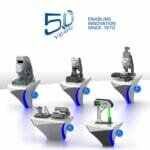Self isolation, social distancing and quarantining is currently having a profound impact on the food packaging supply chain, with consumers switching their buying habits towards longer life products and manufacturers cranking up production to fill empty retail shelves.
As the novel coronavirus crisis continues, the packaged goods value chain is braced for greater challenges. And while there’s currently no evidence to suggest that the virus can be transmitted via food, packaging will play a critical role in reassuring consumers during this unprecedented time.
Already, a survey by the British Plastics Federation has reported a 56% increase in demand for products and services among packaging companies. Many organisations that committed to reducing their reliance on plastic packaging in 2020 have moved away reusable containers and unwrapped goods. Already, there’s been a noticeable spike in demand for single use food containers.
European Managing Director of Fortress Technology Phil Brown explores what this means for food manufacturers, the role metal detectors and x-ray inspection systems can play in reassuring consumers, and why different packaging types and products can affect their performance.
With a metal detector, metals that have one or both conductive magnetic characteristics, such as brass, bronze, ferrous metals etc., will create a detectable signal. Non-magnetic stainless steel is harder to pick up – it’s a bad conductor – and certain food products with added iron, moisture, salt and acids, tend to mask metal detection. Known as the ‘product effect’, this can impact inspection performance.
Technology has however moved forward and detectors are now suited to wet and dry applications. Even conductive products consistently presented in small packaging will be picked up.
With an x-ray machine, light waves pass through the product to be inspected. Anything very dense will block the waves. Yet, low-density materials, such as wood, feathers, bugs, some stones/glass, magnesium and aluminium, allow the light waves to pass straight through.
When working together, Phil says the x-ray machine will favour an in-line inspection position while the metal detector is better at the end-of-the-line, typically where products have been packaged. Gravity systems are the one exception for in-line processing, as the products move through the machine at such a fast speed this type of application doesn’t lend itself well to x-ray detection.
Phil explains: “X-ray machines are getting better, but they’re typically limited to 250 feet, around 75 metres, per minute. A gravity application has products passing through at some 450 metres per minutes, so at that point the metal detector is the best performer.”
Products and their packaging clearly affect detectability. A metal detector was, until quite recently, limited in how it performs on products with added iron and any salt/moisture. Manufacturers of ‘wet’ products often had little choice but to calibrate their metal detection in a way that reduced margins of error. The consequence of this was it tended to trigger excessive numbers of false positive rejects. Simultaneous multi-frequency scanning now makes it much easier for food manufacturers to identify hard-to-find metals in food products with high conductivity, as it’s able to ‘tune-out’ the product effect.
Products that differ in density can impact an x-ray machine’s performance. Although it can be calibrated for the product’s total density, cereal ingredients, raisins and bran for example, have variable densities. Speckles of raisin will be quite high, the bran low and the box they’re in, the same density. As the x-ray is measuring the total density, if there’s a contaminant in the box and the machine lands on a low density bran flake, it may not detect the sample in the same way it would when landing on a higher density raisin.
When it comes to packaging, recycled cardboard can cause issues for both machines. Phil explains: “Cardboard tends to contain ferrous and non-ferrous contaminates, particularly aluminium foil – a big contaminant which an x-ray will overlook- and staples.”
Both machines have potential bonus features for specific products and packaging. Phil explains: “A metal detector offers ‘reverse detection’. A cereal box for example, may have a toy that quite often is identified by a metallised filmstrip. The detector will ensure the toy is there, acknowledging the strip while inspecting for other metals. Similarly, it can ensure oxygen absorbers are packed into meat products while detecting metal contaminants.
“An x-ray has even more potential – it can look for missing components, for example missing ingredients in ready meals or identify a broken or mis-packaged product.”
Phil’s conclusion – both machines work well together, however the metal detector should be the critical control point on the line and the x-ray machine a bonus.








